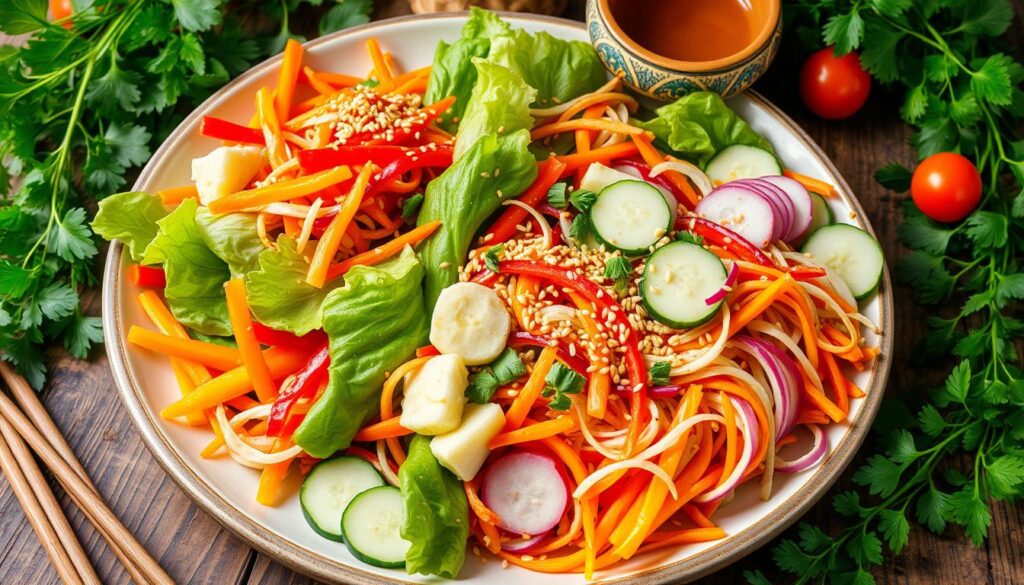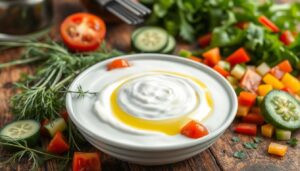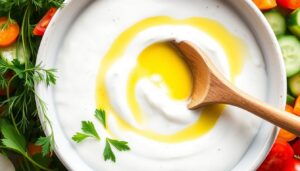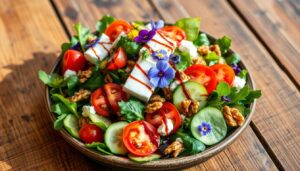I’m excited to share my favorite easy Asian salad recipes. They are not only delicious but also nutritious. From classic dishes to modern twists, these recipes offer a wide range of flavors and textures. They can make any meal special.
Asian salad recipes bring bold flavors and fresh ingredients to your table. They’re a fantastic way to enjoy a mix of crunchy vegetables, zesty dressings, and protein-packed toppings. Whether you’re looking for a quick meal or an impressive side dish, these salads offer versatility and nutrition. Let’s explore the best ingredients, dressings, and techniques to make your Asian salads both delicious and wholesome.
Table of Contents
Understanding the Art of Asian Salads
Exploring Asian cuisine, I find the variety in asian salad recipes amazing. From spicy Korean kimchi to Japanese seaweed salads, each place adds its own twist. The asian cabbage salad is a favorite, with crunchy cabbage, carrots, and cucumbers in a tangy dressing.
In Asian cultures, salads are more than just a side. They clean the palate between courses or cool down a spicy meal. Asian salads differ from Western ones in ingredients and dressings. They use a mix of vegetables, fruits, and proteins, with sauces and seasonings that add depth.
- They are full of vitamins, minerals, and antioxidants from various vegetables and fruits.
- Most are low in calories and high in fiber, helping with weight management.
- They offer a wide range of flavors and textures, keeping meals exciting.
Whether you love spicy Korean kimchi or prefer mild Japanese seaweed salads, there’s an asian cabbage salad for you. With so many options and health benefits, it’s clear why Asian salads are popular worldwide.
Essential Ingredients for Perfect Asian Salads
To make a great asian salad recipe, you need the right stuff. You’ll want fresh veggies, herbs, and proteins. Pick ingredients that are in season and at their best.
A well-balanced dressing is the heart of any great cabbage salad. A mix of soy sauce, rice vinegar, and sesame oil creates a savory, tangy, and nutty flavor that enhances the crisp cabbage. Adding fresh ginger, garlic, and a touch of honey or brown sugar can deepen the taste. To perfect your Asian salad recipe, whisk these ingredients together for a smooth, flavorful dressing that ties everything together beautifully.
- Fresh herbs like mint, basil, and cilantro
- Proteins like chicken, tofu, and shrimp
- Crunchy ingredients like peanuts and sesame seeds
With these ingredients and a tasty dressing for cabbage salad, you’ll have a salad that’s both unique and delicious. It’s sure to wow your guests.
Must-Have Tools and Equipment
To make a great asian salad, you need the right tools and equipment. A well-stocked kitchen is key. The right tools can turn a simple dish into something amazing.
Start with basic kitchen items like knives, cutting boards, and serving utensils. A sharp knife is crucial for thin slices. A non-slip cutting board keeps things safe and efficient. Serving utensils like tongs or chopsticks add a special touch.
Traditional Cutting Techniques
Using traditional cutting techniques is important for an asian salad. Cutting ingredients the same size makes the salad look better. Thin strips or delicate slices add texture and depth.
Storage Solutions
Good storage keeps ingredients fresh. Use airtight containers or zip-top bags for veggies and meats. This keeps them crunchy and flavorful. Always store ingredients separately and label them to avoid contamination.
Serving Accessories
Serving accessories can really make your salad stand out. Decorative bowls, plates, or garnishes add color and appeal. For example, a beautiful ceramic bowl with sesame seeds and orange slices can make a simple salad special.
| Tool | Description |
|---|---|
| Knives | Sharp knives for slicing ingredients thinly and evenly |
| Cutting Boards | Non-slip cutting boards for efficient food preparation |
| Serving Utensils | Tongs or chopsticks for authentic presentation |
Mastering Asian Salad Recipes: A Complete Guide
To master Asian salad recipes, start by selecting fresh, high-quality ingredients like crisp vegetables, lean proteins, and flavorful herbs. Properly preparing your proteins—whether grilled chicken, tofu, or shrimp—ensures a balanced dish. Thinly slicing veggies like cabbage, carrots, and bell peppers enhances texture and presentation. Finally, a well-mixed dressing with soy sauce, sesame oil, and rice vinegar ties everything together. With these steps, you can create a delicious and nutritious Asian salad that suits your taste and dietary needs.
Here are some key tips to get you started:
- Choose fresh and seasonal ingredients for the best flavor and texture.
- Prepare proteins and veggies as your recipe says, and put the salad together just before serving.
- Try different dressings and toppings to find your favorite mix.
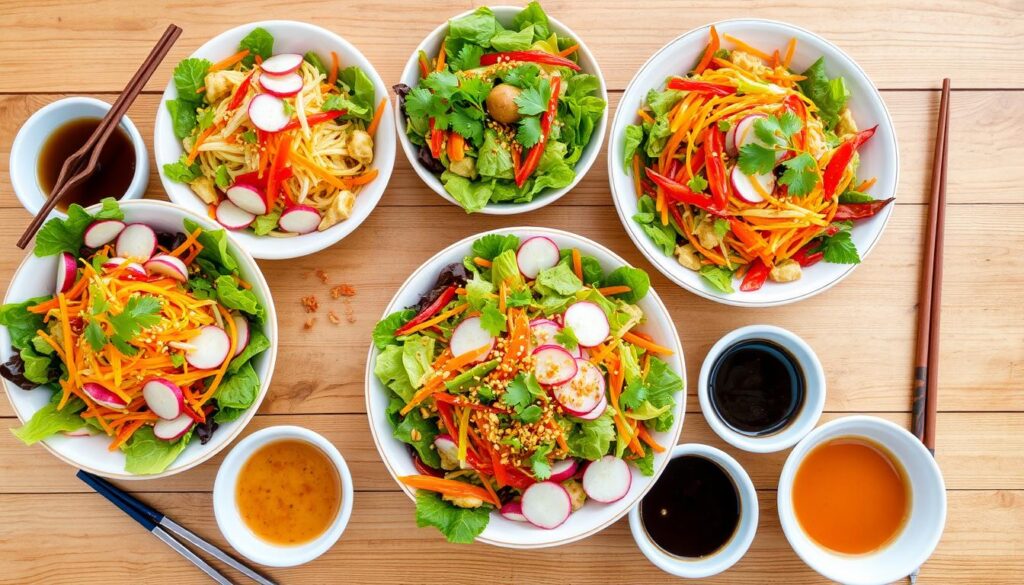
By following these tips and practicing, you can become a pro at
| Salad Ingredient | Preparation Method |
|---|---|
| Proteins (chicken, tofu, etc.) | Grill, bake, or stir-fry as your recipe says |
| Vegetables (cucumbers, carrots, etc.) | Wash, peel, and slice as your recipe requires |
| Dressings (soy sauce, ginger, etc.) | Mix as your recipe says and toss with the salad |
With these tips and techniques, you’ll be well on your way to mastering asian salad recipes and enjoying a variety of delicious and healthy salads.
Classic Chinese Chicken Salad
To make a tasty best chinese salad recipe, knowing the key parts is crucial. The classic Chinese chicken salad is loved for its mix of flavors and textures. It’s a favorite in many Asian restaurants.
This salad has shredded chicken, crunchy veggies, and a tangy dressing. You’ll need fresh ingredients like crisp lettuce, juicy carrots, and chicken breast. Feel free to add or swap ingredients to match your taste and diet.
- Use colorful veggies to make the salad look great.
- Choose a good protein like chicken breast or tofu for texture and taste.
- Try different dressings, like soy sauce or rice vinegar, to find the right flavor.
Follow these tips and use the freshest ingredients to make a delicious best chinese salad recipe. It’s perfect for a quick lunch or a filling dinner. This asian salad is sure to please your family and friends.
| Ingredient | Quantity |
|---|---|
| Shredded chicken | 1 cup |
| Crisp lettuce | 2 cups |
| Juicy carrots | 1 cup |
Vibrant Korean-Style Cabbage Salad
To make a tasty asian cabbage salad, picking the right ingredients is key. Korean-style cabbage salad is vibrant and full of flavor. It’s great for any event. The secret is using crunchy cabbage, spicy peppers, and a sweet and sour dressing.
Here are some tips for making a great Korean-style cabbage salad:
- Choose a fresh and crisp cabbage, such as napa or kimchi cabbage.
- Add some spicy kick with Korean chili flakes or sliced jalapenos.
- Use a mixture of soy sauce, rice vinegar, and honey to create a sweet and sour dressing for cabbage salad.
A well-made asian cabbage salad is perfect for any meal. It’s a hit with its unique flavors and textures. It’s great as a side dish or a light lunch.
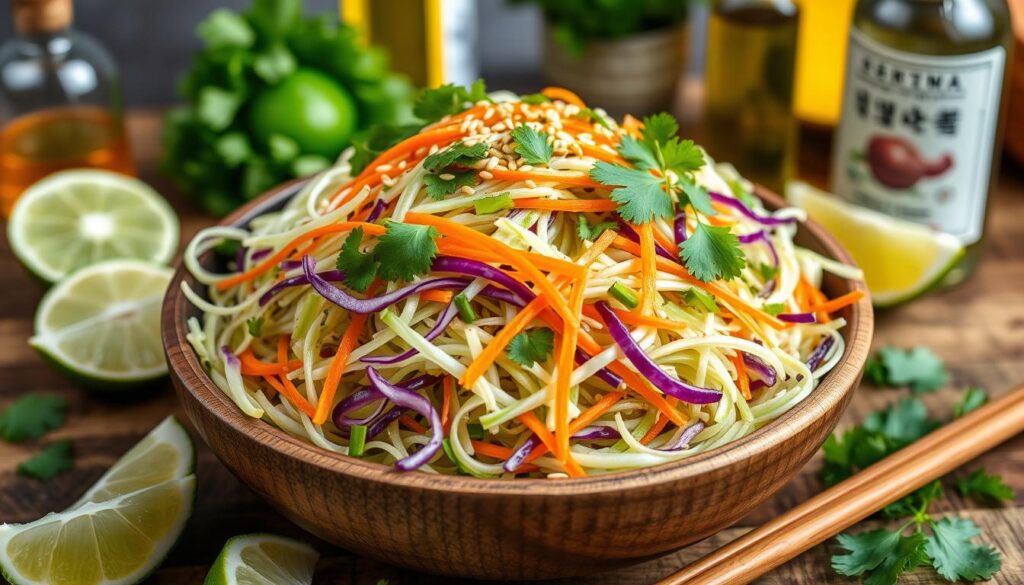
This salad is not only tasty but also healthy. Cabbage is full of vitamins and antioxidants. The spicy peppers add extra flavor and nutrition. This asian cabbage salad is a nutritious and delicious choice.
| Ingredient | Quantity |
|---|---|
| Cabbage | 2 cups |
| Korean chili flakes | 1 teaspoon |
| Soy sauce | 2 tablespoons |
| Rice vinegar | 1 tablespoon |
| Honey | 1 teaspoon |
Japanese-Inspired Seaweed and Cucumber Salad
Exploring Asian salad recipes, I’m drawn to Japanese cuisine, where simplicity meets bold flavors. A standout is the seaweed and cucumber salad—light, refreshing, and packed with umami. Made with marinated seaweed, crisp cucumbers, and a tangy dressing of rice vinegar, soy sauce, and sesame oil, it’s a perfect addition to any Asian salad collection. This dish not only enhances a meal but also offers health benefits, making it a must-try for anyone looking to elevate their salad game.
Choosing the right seaweed is key. Options like wakame, hijiki, and kombu offer different textures and tastes. Experiment to find your favorite.
Choosing the Right Seaweed
Look for seaweed that’s sustainably sourced and low in mercury. You can find it at health food stores or online.
Preparation Methods
Rinse the seaweed and soak it in water for 30 minutes. Slice the cucumber thinly. Mix it with the seaweed. Add soy sauce, sesame oil, and sesame seeds for flavor.
Garnishing Tips
Use green onions, grated ginger, or toasted sesame seeds for garnish. They add color and texture, making the salad appealing.
This asian salad recipe is a great way to enjoy Japanese flavors. Its delicate flavors and textures make it a favorite in any asian salad collection.
Thai-Style Green Papaya Salad
Exploring asian salad recipes leads me to Thai cuisine’s bold flavors and textures. The Thai-style green papaya salad is a standout, with its spicy and sour taste. It’s a favorite in Thai restaurants, loved for its refreshing and addictive mix of flavors.
To make this salad, you need green papaya, tomatoes, chilies, and peanuts. The dressing is key, with fish sauce, lime juice, and palm sugar. These ingredients add depth and complexity. Here are some tips for making the perfect Thai-style green papaya salad:
- Choose a ripe but firm green papaya for the best flavor and texture.
- Don’t be afraid to add heat with chilies or spice – this salad is meant to be bold!
- Experiment with different types of nuts or seeds, such as peanuts or cashews, to add crunch and flavor.
As you explore asian salad recipes, remember balance and harmony are key. Try new ingredients and flavor combinations. With practice and patience, you’ll make delicious and authentic asian salad dishes like a pro!
Essential Asian Salad Dressing Recipes
A good dressing is key to a great Asian salad—it enhances flavors and ties the ingredients together. The right balance of acidity, sweetness, and umami can elevate any dish. Here are three essential Asian salad dressing recipes to make your salads both delicious and authentic:
The cabbage salad is a favorite, and the right dressing can change everything. Try a simple vinaigrette with soy sauce, rice vinegar, and sesame oil. Or, for something more exciting, make a spicy peanut sauce for your best Chinese salad recipe.
Sesame Ginger Dressing
This dressing combines classic Asian flavors that go well with cabbage salad and other Asian-style salads. You’ll need:
- 2 tablespoons sesame oil
- 2 tablespoons soy sauce
- 1 tablespoon rice vinegar
- 1 teaspoon grated ginger
- 1 teaspoon honey
Spicy Peanut Sauce
For those who like a bit of heat, this sauce is perfect. Here’s what you’ll need:
- 2 tablespoons peanut butter
- 2 tablespoons soy sauce
- 1 tablespoon rice vinegar
- 1 teaspoon grated ginger
- 1/4 teaspoon red pepper flakes
These dressings are great for many Asian salads, including the best Chinese salad recipe. Try different ingredients and flavors to find your favorite dressing for your favorite salad.
| Dressing | Ingredients | Flavor Profile |
|---|---|---|
| Sesame Ginger Dressing | Sesame oil, soy sauce, rice vinegar, ginger, honey | Nutty, savory, sweet |
| Spicy Peanut Sauce | Peanut butter, soy sauce, rice vinegar, ginger, red pepper flakes | Spicy, nutty, savory |
Time-Saving Preparation Tips
Preparing asian salad recipes quickly is key. Start by prepping ingredients early. Chop veggies, cook proteins, and mix asian salad recipe dressings ahead. This saves time and effort when you’re ready to assemble the salad.
Here are some tips to save time:
- Chop veggies like cucumbers, carrots, and bell peppers early. Store them in airtight containers.
- Cook proteins like chicken, beef, or tofu ahead. Refrigerate or freeze them for later.
- Mix asian salad recipe dressings in bulk. Store them in the fridge for up to a week.
Also, look for shortcuts like pre-washed greens or pre-cooked proteins. These are common in supermarkets and save a lot of time.
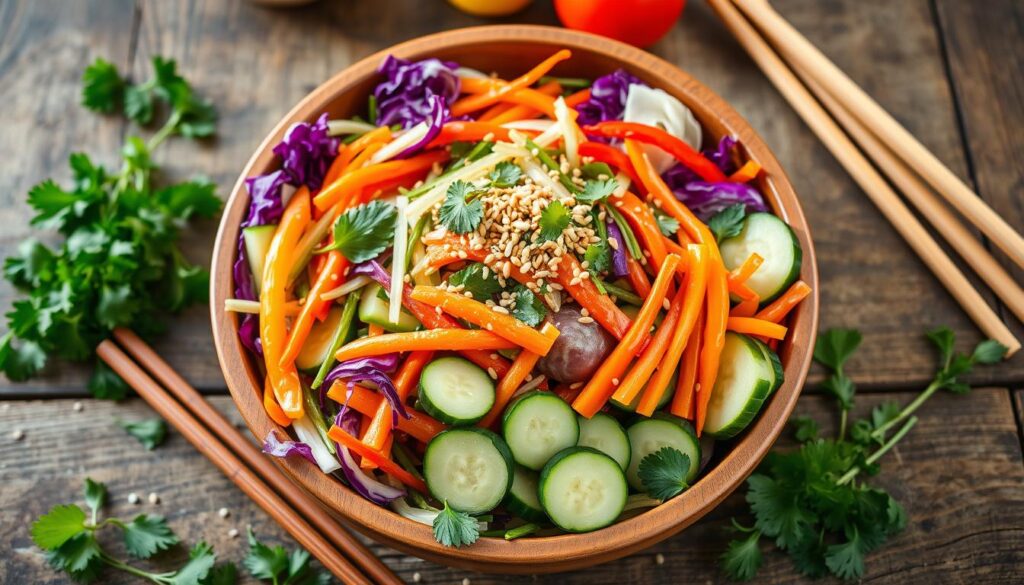
With these tips, you can enjoy tasty and healthy asian salad recipes without spending hours cooking. They’re perfect for busy people or serious home cooks. These tips will help you make the most of your time and create fantastic asian salad recipe dishes.
Make-Ahead and Storage Guidelines
Preparing an asian salad, like an asian cabbage salad, in advance is a great idea. But, it’s important to know how to store it right. This way, you can enjoy your salad for a longer time.
First, choosing the right storage containers is key. You want containers that are airtight and shallow. This helps your salad stay fresh. Glass or plastic containers with tight lids are perfect.
Best Storage Containers
- Airtight, shallow containers
- Glass or plastic containers with tight-fitting lids
Next, temperature control is crucial. Keep your salads in the fridge at 40°F (4°C) or below. This slows down bacteria growth and keeps your salad fresh.
Shelf Life Guidelines
A prepared asian salad can last 3 to 5 days in the fridge. But, it tastes best within a day or two. If you need to store it longer, freezing is a good option. Frozen salads can last up to 2 months.
Common Mistakes to Avoid
When making asian salad recipes, it’s key to steer clear of common errors. These mistakes can ruin the flavor, texture, and quality of your dish. One big mistake is over-dressing, which can turn your salad soggy and unappealing.
Another error is under-seasoning, leading to a bland asian salad recipe. Also, using low-quality ingredients can harm the taste and health benefits of your salad.
Here are some common mistakes to avoid when preparing asian salad recipes:
- Using wilted or brown lettuce
- Not balancing the flavors with the right amount of sweet, sour, and salty ingredients
- Overcrowding the salad with too many ingredients, making it difficult to mix and serve
To make delicious and refreshing asian salad recipes, avoid these mistakes. Use top-notch ingredients, balance the flavors, and dress the salad just before serving. This way, you’ll impress your family and friends.
Seasonal Adaptations and Substitutions
As the seasons change, so do the ingredients for our favorite salads. It’s key to adapt and substitute ingredients to keep salads fresh. Use seasonal produce and adjust dressings to match the season’s flavors.
For spring and summer, use light ingredients like citrus, berries, and herbs. In fall and winter, add depth with roasted vegetables, nuts, and seeds.
Spring and Summer Options
- Use fresh citrus segments, such as oranges or grapefruits, to add a burst of flavor to your asian salad.
- Add fresh berries, like strawberries or blueberries, for a sweet and tangy twist.
- Incorporate herbs, such as mint or basil, to add a bright and refreshing flavor.
Fall and Winter Alternatives
- Roast vegetables, like Brussels sprouts or sweet potatoes, to add a rich and earthy flavor to your asian salad.
- Use nuts, such as walnuts or pecans, to add crunch and depth to your salad.
- Incorporate seeds, like pumpkin or sunflower, for a nutritious and filling addition.
Adapting your salads to the seasons keeps them exciting all year. Experiment with new ingredients and flavors. This way, you can enjoy a delicious and nutritious salad every day.
| Season | Ingredients | Dressing Suggestions |
|---|---|---|
| Spring | Citrus, berries, herbs | Citrus vinaigrette, berry balsamic |
| Summer | Stone fruits, corn, bell peppers | Grilled peach dressing, corn and black bean salsa |
| Fall | Roasted vegetables, nuts, seeds | Apple cider vinaigrette, pumpkin seed dressing |
| Winter | Root vegetables, citrus, kale | Citrus and kale salad dressing, roasted vegetable vinaigrette |
Conclusion
Asian salads are a great way to add flavor and nutrition to your meals. With the right ingredients and techniques, you can make delicious salads. Try the Chinese Chicken Salad or the Japanese Seaweed and Cucumber Salad for a taste of the East.
This guide should inspire you to try new Asian salad recipes. By using Asian cooking principles, you can make salads that are not only healthy but also beautiful. Now, you can impress your loved ones with your Asian-inspired salad creations. Reviewed by Koujil Amine, founder of YummyWhirl, and generated by Emma Chef.
